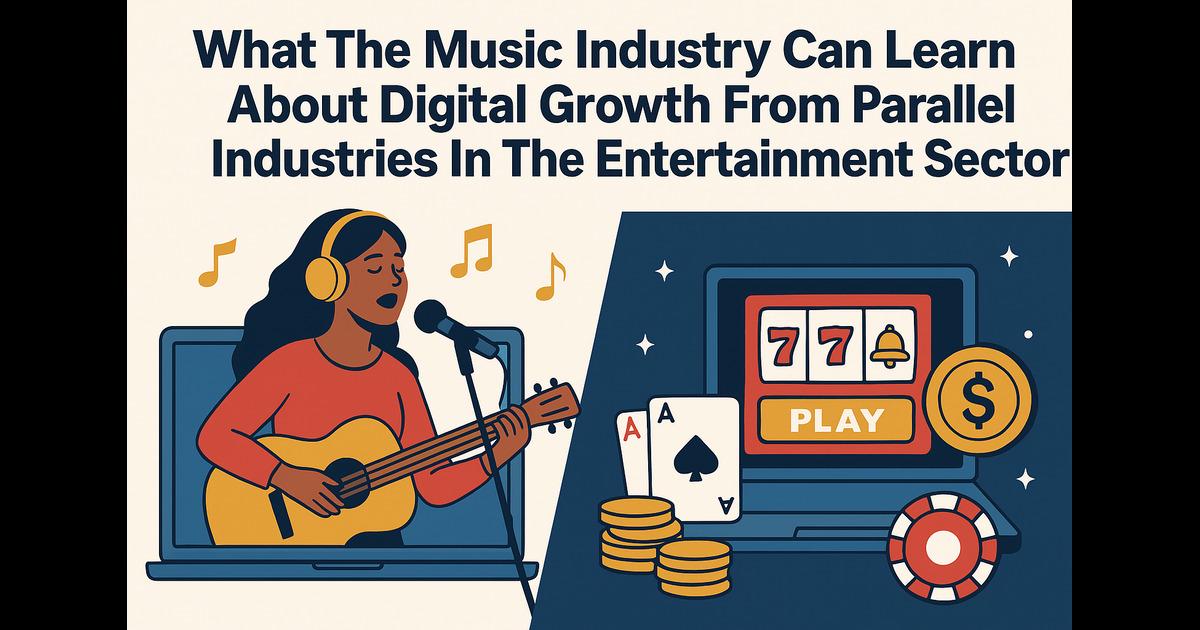How Music Can Learn Digital Growth From Other Industries
The music industry can sometimes seem like it belongs in a vacuum, but its journey into the digital age shows remarkable parallels to other entertainment industries. For example, in all sectors, innovation across platforms and client experience drives development in the current economy.
Industry digitalizations seldom progress independently. Insights gained in a particular business frequently apply across others. This defines tactics and establishes standards for success in the digital space. The global expansion of streaming music and the rapid growth of other digital-first entertainment formats provide a compelling case study in parallel innovation. The common focus on audience interest, platform reach and revenue models can show you how previously assumed niche industries are now at the center of the global digital economy.
Learning from Parallel Industries Like Online Casinos
Online gaming and the entire music business might not have the same audience or cultural significance, but you'll see that both have had to use digital uptake to achieve long-term success. Statista reported that revenue across the global casino games market will reach US$55.52 billion by the end of 2025. Furthermore, it is expected that players at NZ online casinos will amount to 2.0 million users by 2030. These statistics highlight just how much online gaming has been a model in the global entertainment economy.
In much the same way, the International Federation of the Phonographic Industry (IFPI) reported that global recorded music revenues grew by 4.8% in 2024, marking the tenth consecutive year of expansion. Streaming, now accounting for 69% of global music revenues, demonstrates how digital accessibility and convenience can reshape entire industries.
The parallels lie in how both sectors embraced digital platforms not simply as extensions of physical spaces, but as central hubs of customer experience. Online gaming reimagined the thrill of betting on mobile devices with live dealers and interactive games, meanwhile, music shifted from when you had to buy physical media and downloads to a subscription streaming business that values access over ownership. In both instances, the digital shift hasn't just increased revenues but built durable ecosystems on which future innovation can grow.
How Streaming Redefines the Stage
To performers, the stage no longer exists in the realms of clubs or arenas. Streaming media has reshaped the “performance space” so that now artists have immediate access to a global audience. The same IFPI report documented in 2024, there are 752 million paid music subscription accounts around the world, a figure that reflects how music is currently being absorbed.
The entertainment industry overall has experienced comparable movements in redefining the “venue.” Physical locations once were associated with geography as well as expensive overhead. In the digital era, the experience is now worldwide, accessible around the clock and more customised.
Like streaming music services Spotify and Apple Music, which constructed recommendation engines, other digital-native entertainment media employ comparable tech to make users more customized. This creates a dynamic where convenience and customization are the languages of success.
The development of streaming also shows the strength of an industry once regarded as fragile under digital disruption. Piracy, which menaced music’s revenues during the early 2000s, was replaced by formulas that harmonized artist exposure with commercial viability.
Social Media as the Modern Tour Bus
The mass popularity of social media has provided new avenues for music artists to reach you. Whereas they once had no choice but to use tour buses and live shows to create fanbases, contemporary artists employ social media like TikTok, Instagram and YouTube to maintain real-time relationships. Careers can get kick-started by viral trends, yet their online exposure usually supersedes conventional channels for advertising.
Other forms of entertainment also use social media to create presence, demonstrate innovation and connect with worldwide populations. In addition to advertising, these sources provide real-time streaming, real-time events and community-driven materials. The strength here is consistency and malleability: whether they advertise a new album or introduce a new entertainment feature, social media becomes a direct pipe to global populations.
Both music and digital entertainment demonstrate just how central storytelling and interaction are in the digital age. A popular song on TikTok can propel an artist from obscurity to global stardom; other fields profit by the same viral routes.
Capitalizing on Imaginativeness in a Virtual Economy
Possibly the strongest parallel lies in the way industries in the entertainment business explore digital creativity. In music, subscription models and micro-payments through channels like YouTube offer regular revenue flows despite arguments over fairness to artists. Different digital entertainment ventures cash in on interaction through easy points of entry, variability in formats and real-time interaction.
Both point toward the necessity of moving on from one-time transactions to long-term relationships. Rather than purchasing a one-time album, customers now pay a monthly fee for unlimited access. Rather than interacting sporadically, members can access entertainment portals on a regular basis and the common denominator is the demand-driven economy, where consumers seek flexibility, immediacy and customization.
Future-Proofing Careers With Non-Music Skills
The shift towards digital-first industries poses a crucial question for creators and professionals: how do they future-proof? For music makers, this goes far beyond composition or live performance meaning that data analytics, branding, digital marketing and content creation now feature as a baseline set of requirements in order to stay in the frame. In sum, adaptability on a global scale, coupled with an emphasis on digital skills, is the foundation upon which the 21st century will sustain its own growth.

Premium music analytics, unbeatable price: $19.90/month
11M+ artists, 100M+ songs, 19M+ playlists, 6K+ festivals and 100K+ labels on one platform, built for industry professionals.


